Sonic Delivery Haz-Mat Policy
Classification of Hazardous Materials
Hazard Identification
Placards and Labels
Markings
Shipping papers
Download Complete "Emergency Response Guidebook"
Sonic Delivery Haz-Mat Policy
As a general rule, Sonic Delivery does not transport hazardous materials by air, but there are some exceptions made on a case by case basis. Our policy generally follows that of the published IATA guidelines. For more information on the IATA Dangerous Goods Regulations please refer to their web site www.iata.org.
Sonic Delivery can and will ship hazardous materials via surface transport. Contact our operations office for details at 1-800-462-5815.
Options for surface transport include non-stop team operations, hot shots and standard air truck (expedited).
There are certain hazardous materials that can NEVER be air transported. These "forbidden" substances are not permitted on any aircraft at any time under any circumstances!
Forbidden Materials:
-
Compressed gases
-
Explosives
-
Poisonous gases (Inhalation Hazards)
-
Certain flammable liquids and solids
-
Spontaneously combustible substances
-
Infectious substances (Bio-Hazards)
-
Radioactive Material
-
Magnetized Materials
-
Certain corrosive substances
A complete list of specific forbidden substances can be found in the IATA Dangerous Goods Regulations publication.
Before shipping dangerous goods please refer to the IATA Dangerous Goods Regulations or if you are considering ground transport review U.S. Title 49 CFR (Federal Regulations) part of which is presented below for your convenience.
Shippers are reminded that YOU are responsible for proper documentation and identification of all shipped materials. Shipper must supply proper haz-mat placards (4 ) to vehicle making pick up at your facility per federal regulations. See details below.
[Back to top]Classification
of Hazardous Materials
U.S. DEPARTMENT OF TRANSPORTATION
TITLE 49 CFR PART 172.101
The DOT has broad authority to regulate hazardous materials that are
in transport, including the discretion to determine which materials
shall be classified as "hazardous". These materials are placed in one
of nine categories, based on their chemical and physical properties.
Based on the classification of the material, the DOT is also responsible
for determining the appropriate packaging materials for shipping or
transport. Finally, also based on the material classification, strict
guidelines are furnished for proper labeling/marking of packages of
hazardous materials offered for transport, and for placarding of transport
vehicles.
- Class 1: Explosives
- Division 1.1 Explosives with a mass explosion hazard
- Division 1.2 Explosives with a projection hazard
- Division 1.3 Explosives with predominantly a fire hazard
- Division 1.4 Explosives with no significant blast hazard
- Division 1.5 Very insensitive explosives
- Division 1.6 Extremely insensitive explosive articles
- Class 2: Gases
- Division 2.1 Flammable gases
- Division 2.2 Nonflammable gases
- Division 2.3 Poison gas
- Division 2.4 Corrosive gases
- Class 3: Flammable liquids.
- Division 3.1 Flashpoint below -18oC (0oF)
- Division 3.2 Flashpoint -18oC and above, but less than 23oC (73oF)
- Division 3.3 Flashpoint 23oC and up to 61oC (141oF)
- Class 4: Flammable solids; spontaneously combustible materials;
and materials that are dangerous when wet
- Division 4.1 Flammable solids
- Division 4.2 Spontaneously combustible materials
- Division 4.3 Materials that are dangerous when wet
- Class 5: Oxidizers and organic peroxides
- Division 5.1 Oxidizers
- Division 5.2 Organic peroxides
- Class 6: Poisons and etiologic materials*
- Division 6.1 Poisonous materials
- Division 6.2 Etiologic (infectious) materials
- Class 7: Radioactive materials
- Any material, or combination of materials, that spontaneously gives off ionizing radiation. It has a specific activity greater than 0.002 micro curies per gram.
- Class 8: Corrosives
- A material, liquid or solid, that causes visible destruction or irreversible alteration to human skin or a liquid that has a severe corrosion rate on steel or aluminum.
- Class 9: Miscellaneous
- A material which presents a hazard during transport, but which is not included in any other hazard class (such as a hazardous substance or a hazardous waste).
- ORM-D: Other regulated material
- A material which, although otherwise subjected to regulations, presents a limited hazard during transportation due to its form, quantity and packaging.
- * The words "poison" or "poisonous" are synonymous with the word "toxic".
Hazard Identification
Hazard communication forms the backbone of emergency response, and response begins with identification. The primary mission of DOT hazard communication is to alert the public and transportation workers of the presence of hazardous materials, and to insure that incompatible materials are segregated when placed in the same transport vehicle, storage area (or lab!). The distinctive DOT system of labeling and placarding provides another visual clue for responders to a hazardous material incident.
Hazard markings, labels and placards are a common approach to warning the public of hazards that may be encountered. The DOT uses labels, defined as 4" x 4" colored diamond with warning words and graphics, affixed to the outside of the shipping container or box. Labels are required on the outside of the package regardless of the quantity shipped. The DOT requires placards, a much larger version of the labels, to be displayed on tank cars, cargo tanks, portable tanks and bulk packaging. Requirements for placarding are dependent upon the identity and quantity shipped. "Markings" are required to convey specific information about the enclosed hazard and the person responsible.
Placards and Labels
Placards are used to represent the hazard classes of materials contained within freight containers, motor vehicles or train car. Labels communicate the same hazards for smaller containers and packages offered for transport. Examples of the placards and labels used for the various hazard classes follow.
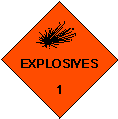 |
This placard or label is used to designate explosive materials, specifically Class 1.1, 1.2 and 1.3 explosives. Explosives that belong to classes 1.4, 1.5 and 1.6 will have that specified, with the class designation replacing the exploding ball. This placard is required when transporting ANY quantity of a Class 1.1, 1.2 or 1.3 explosive, or over 1001 lbs of a Class 1.4 or 1.5 explosive. |
| The placards and labels below are used to designate compressed gases. Given the diverse chemical properties of compressed gases, this class is subdivided into flammable gases (Class 2.1), nonflammable gases or oxygen (Class 2.2) and poisonous gases (Class 2.3). | |
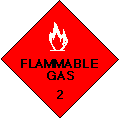
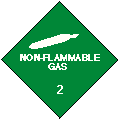 |
|
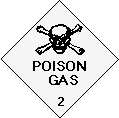 |
This placard is required when transporting over 1001 lbs of Class 2.1 or 2.2, or when transporting ANY quantity of poisonous (Class 2.3) gas. |
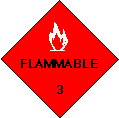 |
Flammable liquids are identified by this placard / label. Certain
common flammable liquids have their own placards, where the name
of the material (such as gasoline and fuel oil) replaces the word
"FLAMMABLE". Also, materials that fit the definition of a combustible
material, have the word "COMBUSTIBLE" replacing the word "FLAMMABLE".
Required when transporting over 1001 lbs of flammable materials. |
| The placards and labels below are used to indicate cargo containing flammable solids (Class 4.1), materials that are pyrophoric (i.e., ignite in the presence of oxygen) (Class 4.2), and those that react adversely when exposed to water or humidity. (Class 4.3). These placards are required when transporting over 1001 lbs of Class 4.1 or 4.2 materials, or when transporting ANY quantity of a water reactive material (Class 4.3). | |
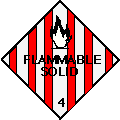
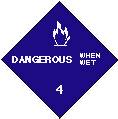
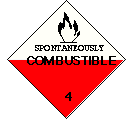 |
|
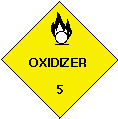 |
This placard or label is used to designate cargo that contains oxidizing materials (Class 5.1). In addition, this class contains materials that are classified as organic peroxides (Class 5.2), and in that case the label would read "ORGANIC PEROXIDES" rather than "OXIDIZER". Placards are required when transporting over 1001 lbs of oxidizers or organic peroxides. |
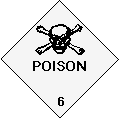 |
This class contains poisonous liquids that are designated as inhalation
hazards. If the material is toxic, but not an inhalation hazard
it is placed in Class 6.1. Materials in these classes may NOT
be transported in the same cargo as foodstuffs, feed, or any other
edible substances intended for humans or animals. In addition to the POISON label, packages of 110 gallon capacity or less, and that are recognized as "inhalation hazards", must also be marked "INHALATION HAZARD". Placard is required when transporting ANY quantity of Class 6 material, and when transporting over 1001 lbs of a Class 6.1 material. |
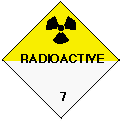 |
This label is required on all radioactive materials and equipment.
Packages containing radioactive species must be clearly labeled
with 2 labels on opposite sides of the package. This class is divided
into 3 divisions - I, II and III. Placard is required on ANY quantity of radioactive material rated as III; it is not required on materials rated as I or II. |
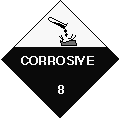 |
This placard / label is used to designate any corrosive liquid.
Placard is required whenever the quantity exceeds 1001 lbs of a corrosive liquid. |
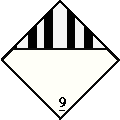 |
Class 9 materials are those that have not been placed in a hazard
class, but may still pose some degree of danger in transport. Placard
is not required for materials that are not classified. However,
you may placard a material that presents a hazard during transport
and weighs more than 1001 lbs. |
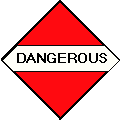 |
This applies to placarding only and is required when 1001 lbs or more of material is transported and it is composed of 2 or more hazard categories. It will replace the specific placards for the individual classes. An exception is when one single class in a multiple class transport exceeds 5000 lbs, in which case the placard for the large load class must be displayed. |
Each person offering for transport a hazardous material must ensure the package, container or vehicle carries the markings appropriate for the corresponding hazard. Specific rules and requirements are outlined in CFR 49 172.300. The following requirements are generally true, though exceptions are the rule!
- The proper shipping name and the proper identification number (preceded by UN or NA as appropriate)
- The identification number (below), when required, may be displayed separately from the warning placard. If so it must consist of black writing on an orange background. If the identification number is displayed on the warning placard itself, it shall be black writing on a white background and will replace the warning wording on the placard, but not the graphic. The identification number must be affixed to each side and each end if the packaging has a capacity of 1,000 gallons or more. It must be affixed on opposite ends if the packaging capacity is less than 1,000 gallons.
![]()
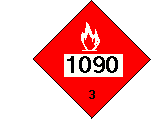
- The markings must be durable, in English and printed legibly.
- They must be displayed on a background of sharply contrasting color.
- They must be un-obscured by labels or attachments.
- The markings must be placed sufficiently far from other markings, such as advertising, so as not to detract from them or less their effectiveness.
In addition to the above general requirements, some materials require that specific markings be displayed on packages and on vehicles when offered for transport. The guidelines for these materials are as follows:
- For radioactive materials, each package must have its weight clearly
marked on the outside of the package. The packaging type (TYPE A or
TYPE B) must be clearly marked on the outside of the package.
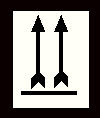
Liquid hazardous materials in non-bulk packaging must be packaged with the closures upward and be legibly marked with package orientation markings pointing in the correct upright direction. Markings that depict arrows for purposes other than to indicate the upward position may not be used on hazardous liquid materials. This requirement does not apply to packaging where the interior package is a metal cylinder.
- Bulk packages which contain materials that are poisonous if inhaled
must be marked with the warning "Inhalation Hazard" on two opposing
sides. Non-bulk packages must be marked with the word "POISON" within
6 inches of the closure.
- Non-bulk packages of materials classified as ORM-D must be marked on at least one side or end with the ORM-D designation directly below the proper shipping name of the material. This marking is certification by the person offering the material for transport that the description, classification, packaging, marking and labeling are all correct and appropriate for the material.
Shipping Papers
Whenever a hazardous material is offered for transport, it must be accompanied by proper shipping papers, which fully identify the hazards involved.
The description must fulfill the following requirements:
- If a hazardous material and a non-hazardous material are described
on the same shipping papers, the hazardous material must be:
- named first
- shown in contrasting (highlighted) color on all copies of the form
- identified with an "X" in the column marked "HM".
- The shipping description must furnish:
- proper shipping name
- hazard class or division (this from column 3 of the Hazardous Materials Table)
- identification number (this from column 4 of the Hazardous Materials Table)
- packing group (this from column 5 of the Hazardous Materials Table)
- except for empty packages, the total quantity, including unit for measurement, of the hazardous material.
- Entry must be legible and in English.
- Unless specifically authorized or required, the description may not contain codes or abbreviations.
- Additional information must follow the basic description.
- Must contain the name of the shipper when transported by water.
- If more than one page is required, the first page must indicate multiple pages, i.e., "page 1 of 3".
- Shipping paper must show an emergency response telephone number.
- Shipping paper must contain shipper's certification. Click here to view an example of proper shipping paper entry.
Emergency Response Guidebook
The Emergency Response Guidebook is a required tool for shippers and carriers engaged in the transport of hazardous materials.
Download the complete 2000 edition of the Emergency Response Guidebook in PDF format by clicking the link below. You must have "Adobe Acrobat Reader" installed on your computer to view the file. If you do not have "Adobe Acrobat Reader" you must download it first by clicking on the "Adobe" icon.
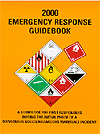 |
GUIDEBOOK CONTENTS
-
1-Yellow-bordered pages: Index list of dangerous goods in numerical order of ID number. This section quickly identifies the guide to be consulted from the ID Number of the material involved. This list displays the 4-digit ID number of the material followed by its assigned emergency response guide and the material name.
-
2-Blue-bordered pages: Index list of dangerous goods in alphabetical order of material name. This section quickly identifies the guide to be consulted from the name of the material involved. This list displays the name of the material followed by its assigned emergency response guide and 4-digit ID number.
-
3-Orange-bordered pages: This section is the most important section of the guidebook because it is where all safety recommendations are provided. It comprises a total of 62 individual guides, presented in a two-page format. Each guide provides safety recommendations and emergency response information to protect yourself and the public.
-
4-Green-bordered pages: This section contains a table which lists, by ID number, TIH materials, including certain chemical warfare agents, and water-reactive materials which produce toxic gases upon contact with water. The table provides two different types of recommended safe distances which are "Initial isolation distances" and "Protective action distances."
-
INTRODUCTION TO THE TABLE OF INITIAL ISOLATION AND PROTECTIVE ACTION DISTANCES (pages 311-312).